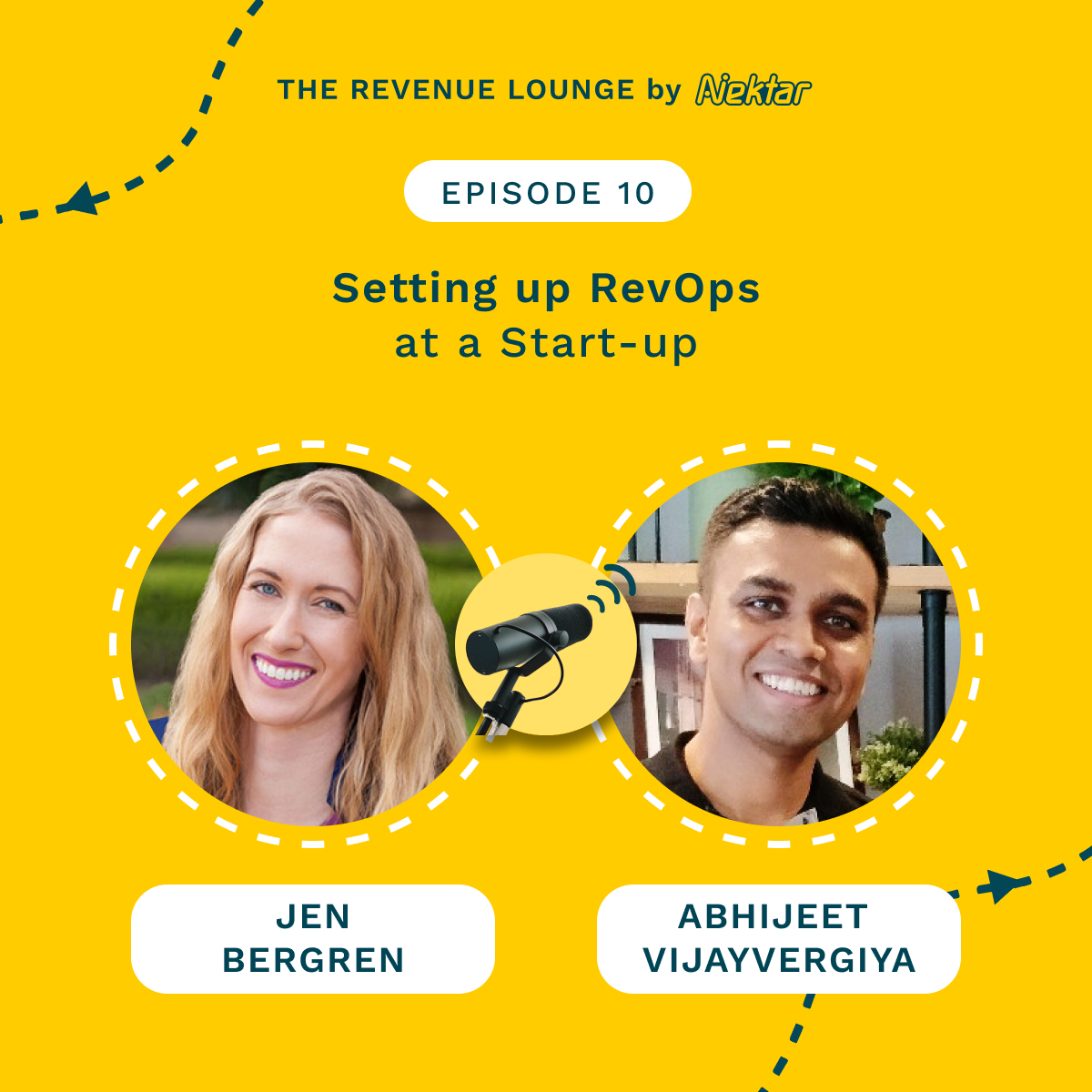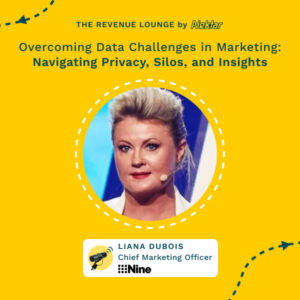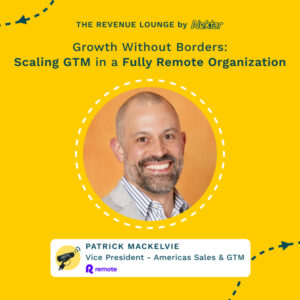Driving an Inbound-Led Outbound Motion ft. Adam Robinson
June 19, 2024
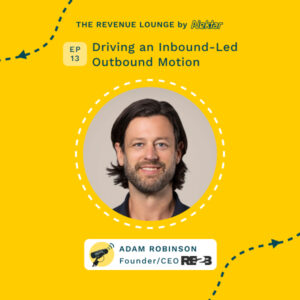
About
The Revenue Lounge
The podcast covers stories from leaders across RevOps, Sales, Customer Success, GTM, Data and Marketing about what drives these functions and what advice they would share with our listeners. With 3 seasons recorded, the podcast currently features 50+ enterprise leaders in the B2B SaaS domain. Tune in to hear from the best in the business
In this episode of the Revenue Lounge podcast, host Randy Likas interviews Adam Robinson, founder and CEO of Retention.com and RB2B. They discuss the challenges with low response rates in B2B outbound prospecting and why traditional methods are becoming less effective. Adam shares insights on new intent-based selling approaches using buying signals and an “inbound-led outbound” model.
Guest Bios:
Adam Robinson:
– Founded retention.com and RB2B
– Former Wall Street trader for over 10 years
– Serial tech entrepreneur and 3rd time founder
– Bootstrapped his companies, grew one from $0 to $22M ARR in 4 years
– Most recent company rb2b already at $500K ARR after just 4 months
Key Topics Discussed:
– The “outbound B2B machine” and why it is broken
– Declining response rates to cold outreach
– Leveraging intent data and buying signals for better targeting
– Transitioning to an “inbound-led outbound” approach
– The role of AI and automation in efficient prospecting
– Re-tooling the SDR role and key skills needed
Notable Quotes:
“Every overnight success is 10 years in the making. I would say that very accurately describes most successful entrepreneurs that I know.” (00:03:11)
“Demand doesn’t get created at Google either. So when Google’s a source, they heard about it somewhere else, and they came to Google to search.” (00:11:21)
“If response rates go to 0, what go to market motion actually works?” (00:14:19)
“I think there’s a crisis in response rates that has a kind of a two sided thing…people are being told to buy less SaaS.” (00:12:03)

[00:00:00] Hello everyone, and thank you for joining me today on the Revenue Lounge. I am your host, Randy Likas, and today we are talking with Adam Robinson. Adam is the founder and CEO of retention. com and our B2B. Adam was a wall street trader for over 10 years and then transitioned into the world of tech entrepreneur.
[00:00:19] He’s a third time founder of a tech startup and has a history of bootstrapping his companies to success. One of his companies grew from zero to 22 million in just over four years. And his most recent company RB2B. Has been running now for only four months. And in that short amount of time has grown to over 6, 500 users and, over 500, 000 in ARR in just those four months, Adam and I are going to be talking today about an issue that we are all struggling with, no matter the size of our company, which is the abysmal reply rates that our teams face when trying to generate pipeline and why outbound B2B as we know, it is broken with all the popularity right now in the market around.
[00:00:57] , buying signals and intent based selling. Adam’s [00:01:00] company, RB2B, is taking on some of the big intent platforms with a differentiated approach, and based on the early success he’s seen in such a short amount of time, is turning some heads and blazing his trail. Adam, thank you for joining me today. Thanks, Randy.
[00:01:16] I’m happy to be here. So, Adam, let’s just take it, from the beginning. I’d love to hear your story a little bit more about, yourself. , how’d you go from being a trader to, a tech founder bootstrapping, your company’s success. Yeah, so I graduated college in 2003.
[00:01:30] I’m 43 years old. I grew up in Houston, moved to New York. I got a job at an investment bank called Lehman Brothers. I traded credit default swaps and my roommates, the first day I showed up in New York, two of them were starting a startup. It’s called Vimeo. Like I remember walking into this one room in our house and they were using this app called Dreamweaver and making the homepage in HTML of Vimeo.
[00:01:54] And, we all know what happened there. It became one of the second largest video sharing website in the world. And so I had this trading [00:02:00] career, which was great and super interesting. But I really just watched these guys, , do this and I didn’t really have vocabulary for it at the time, but , I knew they were getting more out of their lives than I was getting out of mine.
[00:02:11] So, call it the entrepreneurial bug, whatever you want. I wanted to do what they were doing. And after the financial crisis. Kind of enough bad things happened. Lehman Brothers defaulted. This market that I was trading went away or whatever. I’d save some dough. I just tried to get into tech and that started like the very long and winding road to success.
[00:02:31] Getting to where I am today. So your, experience with some of the early companies was around like emails and B2C and building a business, based on that model of working with e commerce retailers recently, I’d say maybe it’s the fall. , it seems like you’ve really entered this B2B space.
[00:02:48] , and how are you taking some of the experience that you’ve learned and maybe some of your earlier companies and applying that to what you’re doing right now with our B2B? Look for me personally, , my whole journey has been, just getting stuck and getting unstuck [00:03:00] and trying to figure out what’s next or whatever.
[00:03:02] And, there’s so much I have to say about this. It’s like really hard to, , articulate, but every overnight success is 10 years in the making. I would say that like very accurately describes most successful entrepreneurs that I know. I think all of the lessons that I learned from all of my prior companies have given me, , intuition and , views about how the world works and how marketing works and how products should work that, , are the entire reason why this B2B product is going so well.
[00:03:33] , I don’t really know the market or I’m getting to know it now, but I didn’t really before, but, a lot of the lessons that I learned, for instance, we have a free product, we have a freemium offering, right? I became obsessed with this freemium idea from MailChimp. In the first space I was in MailChimp was the dominant Brand in that space.
[00:03:54] And I was just amazed at how unbelievably well this free offering worked and the industry leader, [00:04:00] constant contact did not take them seriously until it was way too late. They were like, Oh, it’s a cheap self serve product. Like blah, blah, blah, blah, blah. Like what happened? MailChimp with 0 of funding sold for 12 times the amount constant contact did three years later.
[00:04:11] Like unbelievable. So yeah, just a lot of the lessons that I’ve learned along the way. , it is who I am now and it has shaped the way that I see the world and make decisions. So I think that’s a good way to articulate that. Was there a particular problem that you saw, , in the B2B space around, , intent or website visitors that, you saw.
[00:04:32] The gap, right, that you guys can build , and if so, , what was that initial, , insight or idea that made you think about going into this space? So this guy, Santo Sharon, who’s my COO, he’s a big B2B data guy. He was an instrumental architect of zoom info and Apollo.
[00:04:47] io. , and I got him to join us to help us scale the business retention. com. , the one that’s, , 22 million ARR and selling into e commerce. Because I thought that was like with what I was seeing at the time, I [00:05:00] thought it was a unicorn twice over. I thought that honing in and an ICP was going to reduce this term problem that we had.
[00:05:05] And it sort of didn’t, it’s a problem. But I hired him to help us scale up that team. And like the whole time we were doing that, he was like, dude, like this person level identity that you guys are doing for eCommerce stores, like no one is doing it on the B2B side. The reverse IP lookup account level is ubiquitous.
[00:05:27] It’s ubiquitous. This is a better signal. And furthermore, if it works for people selling a hundred dollar pairs of shoes, it’s going to work for people selling 50, 000 software. So we need to build something for these guys. And then, throughout that journey, which, , the sort of like we expected it to be a unicorn twice over and the expectations ratcheting down.
[00:05:47] And basically , the resting place of retention. com is like, The churn is bad and the TAM is not as big as we thought it was, which is why the business just looks a lot different. , the B2B market has , some [00:06:00] incredible underlying fundamentals in terms of how large it is. , the demand for this product that we pushed out a few months ago is just like unbelievable.
[00:06:09] And I am so encouraged by, , All that I’m seeing. Yeah, but the real reason I did it, if Santos wasn’t there, I would’ve never done it. So Isn’t that right? It was him, yes. Him pushing the, you know, several times I shut it down and the real reason why was like this product that we’re talking about, R B2B, the B2B one, the current way it’s built is that it resolves to a LinkedIn profile and a business email.
[00:06:33] And we push that into a Slack channel so that like somebody, you know, a rep can do follow up with an ICP visitor. I was thinking about the product when he’s like, we need to build this to be executed and implemented very similarly to our DTC product, which is resolved to a deliverable consumer email address.
[00:06:52] And then in a very, untailored mass marketed way, outreach begins. So , I was just thinking that time to value [00:07:00] of that, like there may be some value for some people, but like proving out the value of like kind of mass emailing or even like autoresponder style. emailing a consumer email address about a B2B product.
[00:07:14] I just didn’t see it, you know? Yeah. But then it was this sort of slow roll to like once that LinkedIn URL, like in the business email hit slack , with a headshot next to it. It’s like, wow, that is magic. You know what I mean? That is amazing. So, that was the evolution of it.
[00:07:31] The big problem that I think you guys are solving for is, the de anonymization, right, of the people visiting the site. Giving the sales rep or the SDR, whoever it is, an actual name to call, right, is phenomenal.
[00:07:43] , let’s transition the conversation a little bit to a topic that I think, you know a lot about, which is, the outbound, Machines that we’ve built over the past couple of years are really broken. Right. So just to give you a little bit , of history, I started, over at Outreach in, , may of 2021.
[00:07:57] I was an early enterprise rep over there, and it was just before [00:08:00] the peak of sales engagement. . And a little over a year from kind of the early signs of , the tech downturn. And when I started in May, we were going into that final quarter of Q2 and, you know, people were just printing money at the time.
[00:08:11] Like sequencing platform was selling like hotcakes, right? We were growing at all, you know at all costs like zero interest. Rates People were just blowing out the quarterly numbers at the individual and at the organizational level, right? I remember the vp of our enterprise business saying at one time that he had dinner With a partner at One of the big strategic advisory firms and he’s like, you know There’s not a CFO around who hasn’t done at least the back of the map can math to look at how they can take this big bloated field sales organization that they have and turn it into this digital selling, , semi SDR, like inside sales type of model.
[00:08:46] So then, you know, fast forward about a year towards the later half of 2022 is when we started hearing some of the whispers from some of our clients who are thinking a little bit differently. They’re starting to read the tea leaves and started [00:09:00] questioning, what is the unit economics for us generating a meeting?
[00:09:04] We’ve gone in , this really strong hiring phase over the past year to hiring ahead of demand. And man, the top of the funnel investments are just not paying off like they were, right? The decline in response rates were coming in really, really heavy. And so, then the big layoffs started happening at the end of 2022 and all throughout 2023.
[00:09:23] At the same time though, with the response rates going down and, , people not picking up the phone, , we started seeing a lot more going into companies trying to look for, Better ways, right? And, what happened? people were just using all these automated prospecting tools to try to grow.
[00:09:38] But they were putting, less personalization, less thought into it. Like it was a volume game and, the inbox was just blowing up, right? People were just not responding back. , and with bad results, managers were wanting to double down with more activity, which only made the problem worse.
[00:09:51] We’d love to hear your experience, Adam, , as being a founder in the past couple of years, like in that environment, , what was your experience?
[00:09:57] It was horrible. [00:10:00] So like around 18 months ago, I had six employees and 12 million ARR. And I was like, this is a unicorn. We need to hire salespeople. We need to, attack this market. It’s going to be , an outbound sales operation. So we got a couple of people doing outbound sales that seemed to work.
[00:10:23] And then we’re like, okay, cool. Let’s grow it to like 10. And then we got 10 people doing outbound sales. Then we had another 10 who were AEs that because they didn’t have full calendars, they were trying to do outbound also. And we were booking like the same amount of demos as when we had just two people doing the outbound sales, you know, and there was a lot going on in 2023, but I don’t think that was a unique experience in 2023.
[00:10:48] I’m pretty sure it’s not because I write about on LinkedIn and it’s like the most engaged with posts of all time are. Basically me saying like we did it and then it sort of became obvious that none of his working my vp sales quit we shrank and [00:11:00] then stuff got better again, but look that was my experience and I think I misunderstood a lot of things like one I don’t actually think in today’s world a bdr is where the demand is getting created I think there’s it happened somewhere else, right?
[00:11:18] It’s kind of like Demand , doesn’t get created at Google either. When Google’s a source, they heard about it somewhere else and they came to Google to search. Right. So I had this realization that if you’re scaling your BDR team, everything else needs to scale with it, that you’re doing in order for them to actually book more demos.
[00:11:34] It’s not a channel on its own. It’s this whole big machine that needs to all grow correspondingly, , like marketing and ops and like all this stuff totally didn’t get that. And I don’t even know if that was the case five or six years ago, right? , I think you could just, add BDRs and they could click more and, you would book more demos.
[00:11:53] But I don’t think that’s the case now. And then, as you alluded to before, I think, there’s a crisis in [00:12:00] response rates that has, like, kind of a two sided thing. One is, It’s not zero interest rate policy anymore. So like people are being told to buy less SAS, right? So why are they going to respond to a prospecting email if they’re being told not to buy anything?
[00:12:13] That’s one side of it. And then two is, as you suggested, as these great tools like outreach and sales loft and whatever became more, , ubiquitous, we got an environment where I will bet you my left arm that more email gets sent out by salespeople in 2025 than 2024 and not by a little, by a lot, Yep.
[00:12:36] And there’s already a lot going out. So , what does that mean? It means there’s less impetus for the recipient to respond. And even if you got something highly personalized, out to this person, they’re not going to look at it, man. So, I had this kind of unique situation where I was trying LinkedIn for the e comm universe, and then.
[00:12:59] Santosh [00:13:00] was like, we should build a B2B product. And even before we built the product, I was like, you know what? I’m going to see if I can start writing about my own problems to revenue leaders on LinkedIn and see if that resonates. And literally in a seven day period, I was like, Oh my God. I went from not understanding anything about this game to being fully dialed in, like it’s all moving in slow mo for me.
[00:13:24] I can totally see crystal clear how this game works. Yeah. And. It kind of led me. So like we’re launching this, then it’s like, okay, we should build the product. Even if the price average with the megaphone, that’s this good. Then a couple of things, one, we’re going to have a brand. So maybe we can start with the mid market.
[00:13:43] That was what I originally thought and do a sales led motion. And then I was like, you know what? I don’t really believe in the sales led motion, like longer term. Right. Cause , I think this crisis and response rates is going to be a problem for inside sales. For what we’re talking about.
[00:13:56] And by the way, what we have to do for retention. com to get customers is this super [00:14:00] expensive field sales thing that totally sucks. It’s like, we got to get people to an event to start a sales motion that gets them on a demo. They go away. We’re good at it, but it’s horrible and it’s expensive.
[00:14:11] So, , I was like, okay, I got this massive megaphone. What does it go to market motion look like in a world where response rates are literally zero. If response rates go to zero, what go to market motion actually works. And I’m like, okay. You know, I got a, the V one of this product is a fairly simple point solution, self install, we got some integrations or whatever that lends itself to a freemium offer and the freemium offer would work really well with this megaphone that I have.
[00:14:43] Cause I get benefits of scale on both sides. You know, I get everyone using the product and everyone reading the content. And, as my personal profile gains in status. I think people, here’s an interesting thing about cold email. I think no matter what the response rate [00:15:00] paradigm is, people will answer an email from someone they know.
[00:15:04] So what I’m saying is I’m actually able to email people in this large LinkedIn audience that I have, and they’ll respond. Pete Crowley, who works for me, cannot, he’s not going to get a response. Right. So like I can send a link message, LinkedIn message to someone who’s reading my content all the time. And they’re going to respond to that.
[00:15:23] Like, yeah, they’re not going to respond to Pete trying to, you know. Pitch slap, RB to B or whatever. So there’s a lot of rebuttals to this. When I start talking about this, people are like, Oh, you know, it’s a point. What about enterprise solution? What about expensive products?
[00:15:39] What about complicated, whatever my response is? Okay. That stuff’s going to go back to the field probably. And I think companies will, start doing parts of what I’m doing to just move people down the funnel. [00:16:00] Yeah. I think that even with super complex products, , this motion for getting people in the funnel and moving them down, like part of the product is free and you get them using it.
[00:16:12] And then , you have a rep come in much later after they’re already sold on it and start tacking on all this other stuff that’s more complex. And, , whatever, like this sort of PLG thing. I think as the field sales to inside sales motion becomes totally ineffective, it just has to go in different directions, right?
[00:16:30] So back to field sales is an obvious one to me, but, , this, Sort of designing products and designing go to market strategies and designing pricing strategies in a way to where it plays into this new world, I think will become a necessity, like getting multiple users inside of a product is really helpful in a lot of ways, when it comes time to actually upsell them, the thing, you know who they are and they have this relationship [00:17:00] with, you know, you got a relationship.
[00:17:01] So there’s a couple things you said there that I want to double click on. One is a hundred percent like people that are familiar with you, that know you, people that trust you or they trust someone else who knows you all the time are going to get a response over, over anybody cold.
[00:17:15] , I also agree with you when you say that, we’re gonna probably inboxes 12 months from now than we do now. Yeah. And, it’s the response rates are going to drop even further, right? Cause people are just, there’s only so much noise that people are going to be able to tolerate before they just say, forget it.
[00:17:29] Even if you’ve got a really good quality message, it’s just going to get drownded in the mass. So a question for you , is around AI, right? , is it a good thing, because AI to help generate more emails without a good message, it’s just going to crowd that inbox, but anybody else also has incredible efficiency.
[00:17:45] So we’d just love to hear. What your thoughts are on AI in this world, top of funnel building pipeline, increasing response rates. Is it a good, or is it a bad thing? So
[00:17:56] I was talking to John Barrows about this last week, [00:18:00] and he’s like, he has this Ironman helmet that he loves putting on and he’s like the top 20 percent of reps are going to become these half robot, half human machines. And they’re going to wield the power of these AI native tools. And they’re going to provide a better selling experience to the buyer than there’s ever been.
[00:18:25] The other 80 percent who do not adapt, might be walking the plank. So look, there’s no question that it will, , increase the amount of just straight spamming that is done by orders of magnitude. I think that. What it can do is it can save enormous amounts of time doing things like researching, you know, pulling out killer personalization that can be done, , in all sorts of enrichment that can make really interesting outreach so that when you can get a signal of true intent and what I think will also [00:19:00] sort of be better at the future is like discerning intent and where that means people are in the funnel.
[00:19:06] And then, someone who has a relationship with that person to actually hit them with a killer message that might’ve taken an hour to write. And it takes 30 seconds. , but the key is, it’s not just a blast, right? You’ve earned the right, where I think it’s gonna be the most effective is when you’ve earned the right For someone to respond to you, meaning they know you and trust you through prior relationship that you have with them and you are hitting them at the right time with the right information.
[00:19:40] That is incredible power of AI. The downside is going to be that it also creates a bunch of B minus sludge that just gets, just annihilates people, you know? So it’s good and bad, right? Yeah. Yeah. I talk with a lot of. leaders each week. I’ve been attending a lot of conferences. I think I’ve gone to four in the past [00:20:00] month.
[00:20:00] , there’s a couple of key themes that I’ve been hearing that kind of been emerging around this topic of, , response rates being so low and how, why it’s so difficult to build pipeline and everything else. , and people, made cuts, right? They’ve cut over their SDR teams, over the past, , 18 months, one, two, even three times, right?
[00:20:17] And they still aren’t getting the return, right. Or the yield that they want , from that team. And so there’s a lot of people starting to question, do we even have this role as an SDR any longer? Right. Is it giving us the right return or do we just put all the pipeline generation on the AEs to go find it themselves or this one’s really interesting is do we retool the SDR and look differently at how we measure them?
[00:20:40] , what they do and how we measure them. And how they’re gold, right? And so, , it’s not about making more calls. It’s about using kind of some of the things you just talked about, using AI in the right ways to do the right research, to hit them with the right messages, so on and so forth.
[00:20:55] , it reminds me of, , this thing that you talk about, which is this inbound [00:21:00] led, outbound type of model, right? , where, you’ve done a really good job sort of building the content that people value, which in turn has gotten you, I think, what, your 80, 000 followers or , something along those lines.
[00:21:11] So that’s insane. That’s fantastic. So tell us more about this, inbound led outbound approach. , and how either an organization or an individual thing organization can start building that playbook. Yeah. I think that the third paradigm that you described retooling the SDR, I think that is inevitable and going to happen.
[00:21:30] We probably need fewer of them because the tools are so powerful and, the master of these tools will probably not be like a bunch of kids out of college or whatever, like it’s a different profile of person that is like executing with these tools, but that’s the world that I see and this whole inbound let outbound thing, it’s just came to my head as the description of what I’m trying to do with our go to market motion right now.
[00:21:55] And I’m not saying it’s right for everybody, but in my opinion, I’m in the perfect situation to do it [00:22:00] because I am my ICP and my ICP So LinkedIn is a platform for me. I’m doing things in the digital and the real world to drive website visits, which then either leads to a zero friction, free signup, or puts people into this intent based, , warm outreach that occurs when they hit the site and tries to bring them back to the site to, basically do this zero friction, free sign up.
[00:22:25] So, the questions that start getting asked at this point, what if my ICP isn’t on LinkedIn? Can I still do this? What I would say is not in the same way that I am doing it, right? Like, it is magical because of all these dynamics. We’re selling tech to people who spend all the time on LinkedIn.
[00:22:46] Your ICP is probably somewhere, they’re probably on social media somewhere, somehow. , and I think that the value of organic social media is just increasing, like knowing how to create good organic social [00:23:00] media content. There has been this shift to interest based algorithms since tick tock before interest based algorithms, it was all based on the number of connections you had and who they were, and that’s what showed up in feeds.
[00:23:13] Now the platforms are warring for attention with each other and it’s whoever can serve the most interesting stuff to you wins. So this is what shorts and reels and tick tock is what it’s all about. What that has created is an alignment between the platform and the content creator where they both want to create the best thing possible.
[00:23:30] Okay. It’s less about your existing audience and it’s more about whether or not you can create really good content consistently. So I think that’s the same for LinkedIn is everywhere else. , but it’s like the value of organic versus just running a banner out or something like that, or paid search or something like that, knowing how to create truly good organic content kind of makes your distribution power unlimited because the platform is not motivated to serve it if it is good, that’s [00:24:00] no small chore.
[00:24:01] I know how to do it on LinkedIn. I don’t know how to do it anywhere else. I have no idea if you were selling to , IT people at hospitals, what the equivalent of this would be. But I think that it’s possible, you know? , so yeah, in an offline world, maybe it’s hosting, drinks once a week to talk about an issue or a topic that those people at those hospitals wrestle with.
[00:24:24] Right? You’re providing some kind of a value add, I think, on the topic to bring like-minded people together on a particular challenge that they’re facing day to day. , it may happen that your product happens to support that, but you’re really not talking about your product.
[00:24:36] You’re talking about content that matters to those individuals, right. Would you agree with that or would you reflect on that? In the end of the day, LinkedIn for me is an unbelievably efficient way for me to build community around these ideas that I have. That is what it is. It’s nothing other than that.
[00:24:55] So, , in the offline world, what you suggested [00:25:00] is building community around ideas just in a different venue. Right? Like the venue for my community building is LinkedIn in the comments on my post. I could take that community to Slack if I wanted to take it off LinkedIn. If I wanted to manage a Slack group or whatever, but like at the end of the day, it’s me not selling.
[00:25:21] I mean, I sell some, but it’s me providing value to these people around this set of ideas. The motivation is not sales. Ultimately it is, but I’m not making this content in any sort of a direct response way. Almost none of it, right? It is in the service of building a large community around the ideas that we stand for.
[00:25:46] And that can be done a million different ways. I mean a million different people in a million different ways have done that. Right? Yeah. Yeah. So one of the things I think either individuals, demand gen leaders, whoever in the audience might [00:26:00] face is the change management of moving away from the model that we’ve used.
[00:26:04] Even though it’s not working, it’s Our metrics are tied to it and everything else. To moving into this model that you’re talking about, this inbound lead outbound engine, what advice or recommendations do you give to somebody that they might take to help, you know, boost, or to stop some of that change management, get it going?
[00:26:22] So here’s what John Barrow said. And, , I kind of like this approach. He’s like, there’s just no way for a sales leader to be able to do their job right now and then develop a deep understanding for this new technology. That’s on its way. He’s like, what I think is a clever idea is you take two hours every Friday and you have a hackathon, but for salespeople.
[00:26:46] So it’s like, here’s this new tech or, you know, we want to experiment with some new email copy, or we want to , look at different types of intense signals or whatever. Yeah. Go in small groups [00:27:00] of four and spend two hours coming up with different ideas about, what can be done , tap into the cumulative brainpower of your organization to try to, bubble up ideas that might make stuff work better and then, gradually shift over time.
[00:27:19] And his advice is to people inside of sales works is. If you can help transition the organization to harnessing the power of these new tools, that will basically solidify the importance of your role for the rest of your life. , you will be one of these iron man, half robot, half human reps. That sort of gets it and becomes super valuable to people.
[00:27:43] Does moving to this sort of model that we’re talking about, , is there an ASP that a company has that where you think this would work best , as your ASP goes higher, does the model still stay the same or does it tap out at a certain point? We’d love to get your perspective on that.
[00:27:58] Yeah, I mean, we’re [00:28:00] so early in the game that I think it’s hard to make a call on that. What I do have a conviction in is once people who have done a lot of selling all different kinds. Once they see some of the stuff that these tools can do, you know, like between our tech clay, , this tool called spark send and this tool called smart lead, you can chain together these workflows that are just unbelievable.
[00:28:29] It’s like sending a personalized video to website visitors that like includes things that are like relevant based on what’s on their website and what pages they viewed on yours. That is bananas, you know? And it’s possible now. I feel like a lot of the, disruptive technology kind of starts at the bottom and then moves its way up.
[00:28:49] Like I would say that’s definitely a characteristic of what’s going on now. Like there’s this whole robust community of clay legion agencies, right. And [00:29:00] like probably most of their clients are on the smaller end, but like some of them are starting to get bigger and bigger clients is , the word spreads.
[00:29:06] This is a super efficient way to do outreach. , yeah, don’t have a great answer, but it’s kind of like bigger every day kind of thing, you know, people are getting better and better at using these tools and making them more precise and more accurate and stuff. So let’s pretend for a moment, I’m an SDR.
[00:29:25] That’s really just always, you work the phones and you work , my sequences, my cadences, and I don’t have the tech understanding of some of these new tools that you talked about, but , I’d like to, who are some of the people or some, you mentioned some of , the stacks that, that work well.
[00:29:38] Like what advice might you give somebody who needs to sort of reskill themselves to operate in this like robot work world?
[00:29:45] Presumably, if you’ve done a lot of selling, you’ve done a lot of enrichment, just like manually, I would like take a list, create a free account in clay. And just click through all of the possibilities [00:30:00] for enriching that list in Clay. And I think it will like, shift your perspective on what’s possible.
[00:30:11] And just watching some of the Clay content and what the agencies are up to. I actually did, , two weeks ago, I do a live webinar every Tuesday. Two weeks ago I did one with one of these guys from Clay. And it’s just amazing what he created in this clay table, like what it was doing.
[00:30:30] He was sending these automated, Omnichain. He was sending like an AI generated voice LinkedIn message where the voice message, the only thing that was AI was like the name, but still that’s pretty cool. But the rest of it, but so he’s dropping that. And then he was sending an email with.
[00:30:53] The person’s headshot in this like frame, I forget what the gimmick was, but [00:31:00] he’s sending like a picture of the person with like the blank of the month or something like that. I don’t even know. It was just crazy. The idea that all of this, like you just turn it on and it just keeps going and it keeps doing this for all your website visitors.
[00:31:14] It’s nuts, you know? Yeah. So I guess what I’m hearing is you just got to get out there and play with some of it, right? Like there’s tons of people talking about how they’re the use cases that they’re using online. Just put the time in and learn it and roll your sleeves up and learn on your own kind of, right?
[00:31:30] Yeah. I would say it is worth at least going down the rabbit hole of these people’s content. This is like clay agency world just to see the type of stuff they’re up to. Yeah. It’s paradigm shifting, it’s just amazing what can be done now. Like Taylor, the guy who does our cold email, , he’s one of these clay experts.
[00:31:51] And he was having this conversation with this enterprise company about, doing some activity with BDRs to call through companies and figure out [00:32:00] information about whatever. And he’s like, how long is it going to take? He was like, it’ll take, a group of 10 people, like six to eight weeks to pull this together.
[00:32:10] And he’s like, I’m going to hit you up in two hours. And he like did the task that they were looking to do with all this, like AI, you know, research or whatever, this enrichment on their list , in 30 minutes, , so again, that’s what I think the power is. If you can harness enough good intent signal, it can just help you save a lot of time creating a perfect message.
[00:32:36] Yeah. The perfect situation is that the person feels like they know you already when you send it. Then I think you’re in a winning paradigm for the future. I just think that is harnessing the power of all of this stuff in the right way. , and that’s what the wrong way is just the last, you know, right.
[00:32:50] And we know that’s not working. , I think what you’re talking about , is how companies are probably going to need to get The yield back on their investment in the SCR or by doing a [00:33:00] lot of this retooling , that you’re talking about. , well, listen, I want to transition to, what we call the lightning round, which is just a couple of questions more personal in nature,
[00:33:09] , so first one off what one lesson or piece of advice would you give your novice entrepreneur yourself? When you founded your first company 10 years ago, , either lessons learned or pitfalls to avoid. What’s, if you had to pick one, what would that be? I think that I didn’t really have an appreciation for how important having a great product was until like five or six years in. Cause I didn’t have a great product until five or six years in and I didn’t feel what it was like to have a great product and , how much easier everything gets. I have this view now that if you have word of mouth.
[00:33:47] Quote, unquote, your product is growing on its own without you helping it. There’s a million things you can do to speed that up. If you don’t have that already, word of mouth as a [00:34:00] startup, there’s nothing that you’re going to do that is going to work. So you’re going to listen to guys like me talk about all this stuff they’re doing.
[00:34:06] , I’m doing this LinkedIn thing and I’m doing this, referral, I’m doing this UGC program. I’m working with these influencers. , none of that works for you unless. You have word of mouth already. So, , it’s just hard. It’s hard to, yeah. , go find a way to create some word of mouth for your company.
[00:34:23] , go find a way to do a lot of it is just building a good enough product to where it has that. And then you come across this problem where it’s really hard when you’re giving your whole life to something, to admit to yourself that your product is not good, because that means you’re not good.
[00:34:43] Yeah, so I think it’s like you kind of like don’t know product market fit until you’ve been on both sides of it And then once you’ve been on both sides of it, you’re like, oh I didn’t have it then and I definitely do now Yeah What’s one piece of advice that you’ve received could be [00:35:00] recent could be in the past that’s really stuck with you.
[00:35:02] This is kind of a quote, but it’s like reputation takes a lifetime to build you can be destroyed in a minute That’s the essence of it and I think , reputation is, , brand. It’s like brand trust, reputation. It’s all this, the same idea, right?
[00:35:16] Like it’s all the only reason anyone buys from anybody is that, and it’s just so delicate and important to preserve it. Yep. What advice would you give maybe a budding entrepreneur, somebody who’s got an idea or they see, something that they can disrupt, , they’re about to make a jump, the jump to be a SaaS founder.
[00:35:34] What advice would you give them?
[00:35:35] , spend as little money as possible until you have a repeatable sales model.
[00:35:39] That is my advice. Yeah. I’m going to , ask you a follow up, which is, would you ever take, I know we talked about your background of being bootstrapping everything. Would you ever take venture funding?
[00:35:48] I say no and I hope not, but who knows Santo showed up and he really wanted us to do growth equity and a combination of the business not doing as well as we [00:36:00] thought in the market evaporating for growth equity. It just turned out to not even be an option. , and I’m glad that it’s not because our business is quite profitable and the consolation prize is like paying out lots of dividends.
[00:36:13] Yeah. , which is super dope. So I’m kind of in the camp where this is my personal place right now. I think I’m like about to have like the world’s best lifestyle business. And that just , doesn’t mix with venture funding., once you take venture, like that’s off the table, like you take your money up front and then, you stop paying yourself every year.
[00:36:34] So, , that’s my long winded answer. , the way it’s going right now, I hope not, but I don’t know, man. , you never know. I feel like I stand for something the opposite of venture funding. I wanna stay with the strapper. So who do you follow?
[00:36:47] Who do you go to idly LinkedIn or otherwise to help cultivate, ideas or, push your thinking? That’s providing either compelling content or, ideas. Yeah. So strangely, I give so much time to [00:37:00] creating content that I don’t really spend that much time absorbing it.
[00:37:08] People who have really helped me in terms of like how I’m presenting myself, Chris Walker for sure. I mean, he built the playbook for putting your face out there. I think he built the playbook for a lot of what I’m doing in many ways. There’s this guy, Nigel Thomas, who I think uses templates really well.
[00:37:29] And if you’re a novice at LinkedIn, I think using templates can really help get better engagement because you can get people to stick on the page for longer and LinkedIn likes that. And this guy, Sam Jacobs, who runs Pavilion, I always thought a year ago my content wasn’t good and I sought out, I saw a webinar with him and his LinkedIn coach consultant, this guy, Alec.
[00:37:51] And, in June of last year, I wanted my content to be better. I reached out to Alec and, , now I’m working with him and I feel like the actual post [00:38:00] itself, his philosophy is just create the best content. It’s not like about engagement circles and all this shit. So, those are the three that have helped me the most.
[00:38:09] Love that. A little bit of a build, off of the question. So what advice do you give somebody who maybe, wants to build this machine, right? They haven’t quite found their voice or they’re not confident in that they’ve got something to say, right? But they want to start doing it.
[00:38:22] , what advice do you give somebody to build , that content? Get a ghostwriter. That, I would honestly, it sounds strange. I get a ghostwriter for like 90 days. Have them, cause each platform is unique. There’s some things that work on LinkedIn in terms of formats in terms of topics We have somebody who spends their life on LinkedIn will be able to guide you in Kind of what ish and how ish you should write?
[00:38:51] So I think working with someone in the beginning, by the way, I work with a ghostwriter too It took me 12 months to really find my voice. I [00:39:00] think if you really want to crush this That’s the kind of commitment you’re looking at like it’s going to take a long time to really, really dial it in. , but you don’t have to really dial it in by the way.
[00:39:11] , there are other benefits to posting content regularly other than this thing that I have going for me, which is just like this dream state. I it’s just amazing. , but yeah, that’s my advice. Work with a ghostwriter to get started and just see If you like what it’s doing for you, a lot of people say, I don’t know what this is doing for me, but I like it.
[00:39:35] And I think the essence of that statement is you start to get inbound that you weren’t getting before by becoming alive on this platform. , and then if you really get the content bug and you want to commit your whole life to it, then I think you’d be great. But I don’t think that makes sense for a lot of people, right?
[00:39:52] It makes sense for me because. I have the opportunity to create like the first B2B influencer founder led [00:40:00] data company that, you know, is basically found this zero customer acquisition cost, funnel, right? , that’s not everybody. Last question.
[00:40:09] You and I talk next year, 12 months from now, what’s going on in the market around, response rates, demand, what predictions do you have? So that when I call you in a year from now, we can see how it all played out.
[00:40:21] I think that all of the trends that we’re talking about will continue to move in the direction that they’re moving in. I think it’s going to be harder. I think there will still be The SDR, BDR, like we’re talking about, but there’ll be fewer of them. I wouldn’t be surprised if more people were experimenting with these kinds of models that I’m experimenting with.
[00:40:43] , trying to bring people into like their more complex funnel with like a PLG, you know, freemium point solution. It’s hard to do, especially if you have an established, you know, a containable at whatever, but like. I wouldn’t be surprised if more people [00:41:00] starting startups do it. Like I am trying to do it.
[00:41:02] And then their product gets more complex over time, but like, that’s like a core part of the funnel. , I think that , we’ll start seeing, I don’t even know what it’s called, like this job description of this, like demand gen like builder or something where it’s like, they’re the master of the demand gen AI tech stack and they got 10 years of experience and they’re mad scientists.
[00:41:28] And they get paid tons of money and they just sit in the middle of these companies like rippling or gone or whatever. And they’re just like extending the spider web out a bajillion ways and then waiting for signal and popping it out and like funneling it all into a few reps to, to bring it home.
[00:41:46] That’s what I think is going to happen. There’s a couple of companies I’ve seen that role starting to emerge and I think you’re right. , I think that’s the, that is the future. , I’m looking forward to , seeing how it all in plays, , in touch and base with you in a year and , seeing what was right and what was wrong.
[00:41:59] But listen, [00:42:00] I want to be cognizant of time here. So Adam, just want to say, really enjoyed the conversation, , appreciate all the insights, for the audience and, , hope you keep continuing to kill it.
[00:42:08] Thank you. Thanks for having me on. All right. Sure.

Ep #1: Navigating the Downturn with a Hyperfocus on Productivity
Listen Now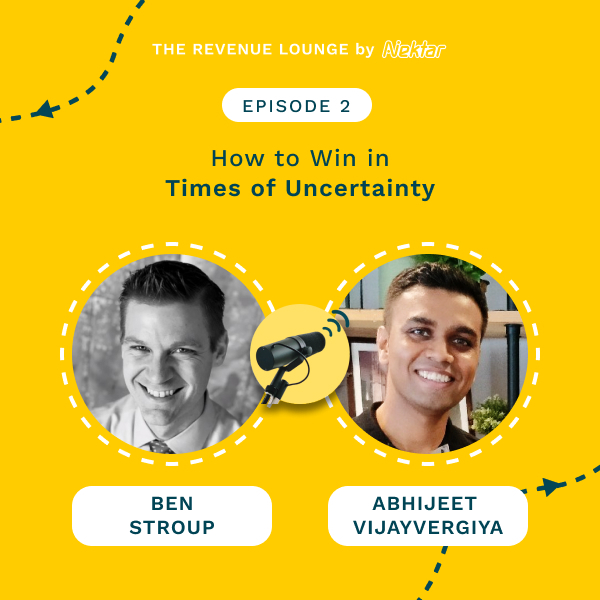
Ep #2: How to Win in Times of Uncertainty
Listen Now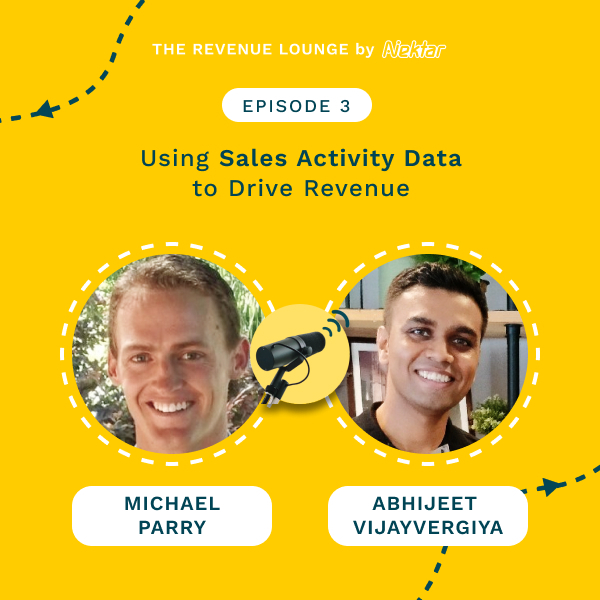
Ep #3: Using Activity Data to Drive Sales Productivity
Listen Now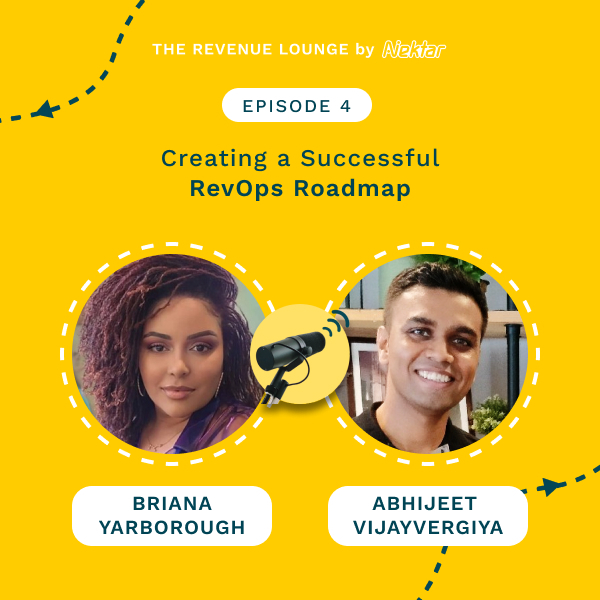
Ep #4: Creating a Successful RevOps Roadmap
Listen Now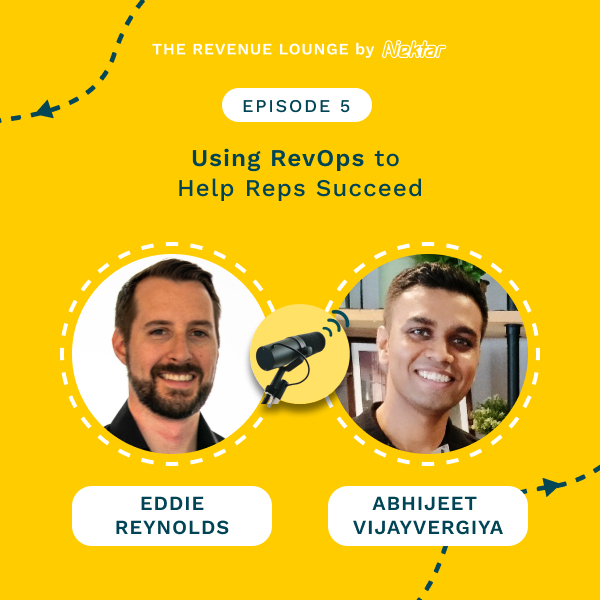
Ep #5: Using RevOps to Help Reps Succeed
Listen Now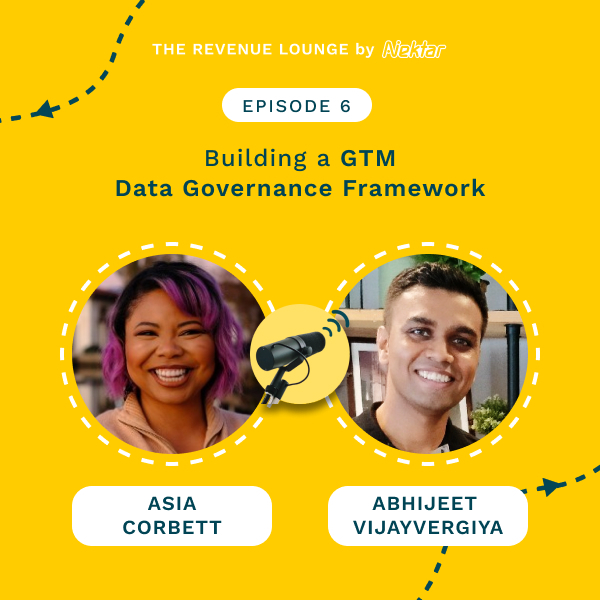
Ep #6: Building a GTM Data Governance Framework
Listen Now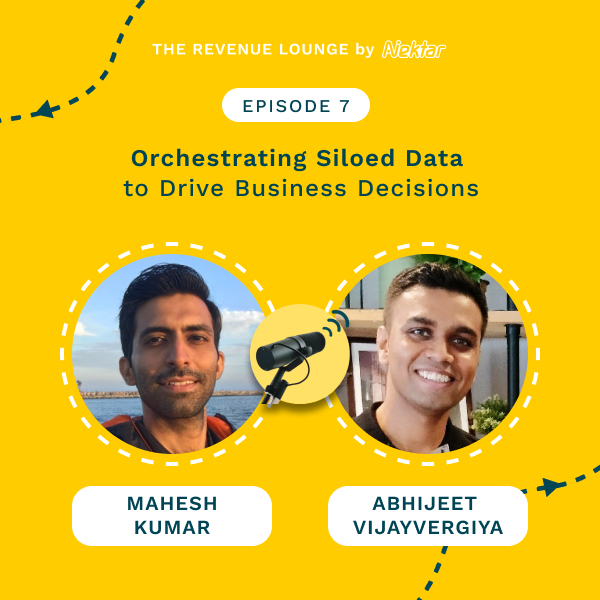
Ep #7: Orchestrating Siloed Data to Drive Business Decisions
Listen Now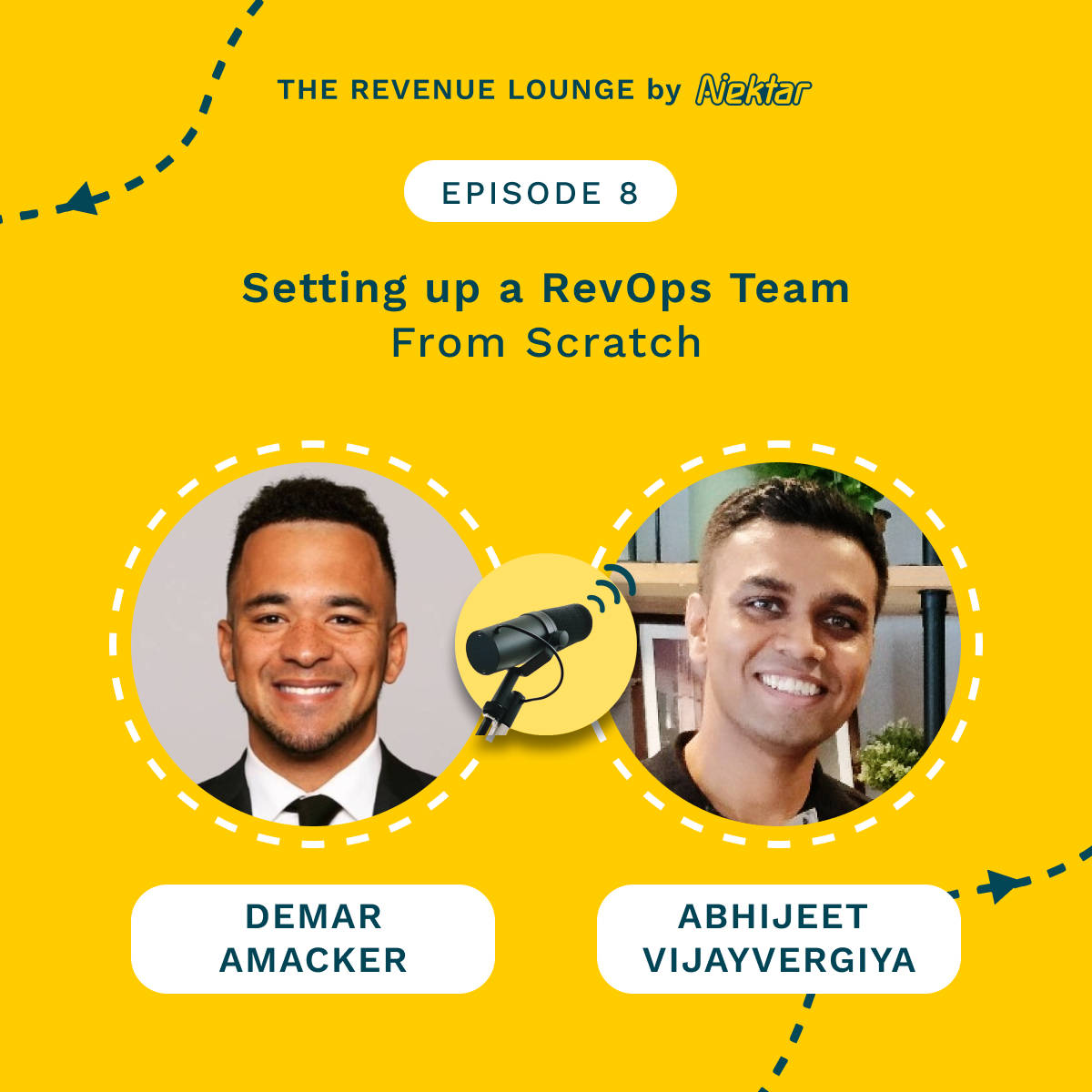
Ep #8: Setting Up a RevOps Team From Scratch
Listen Now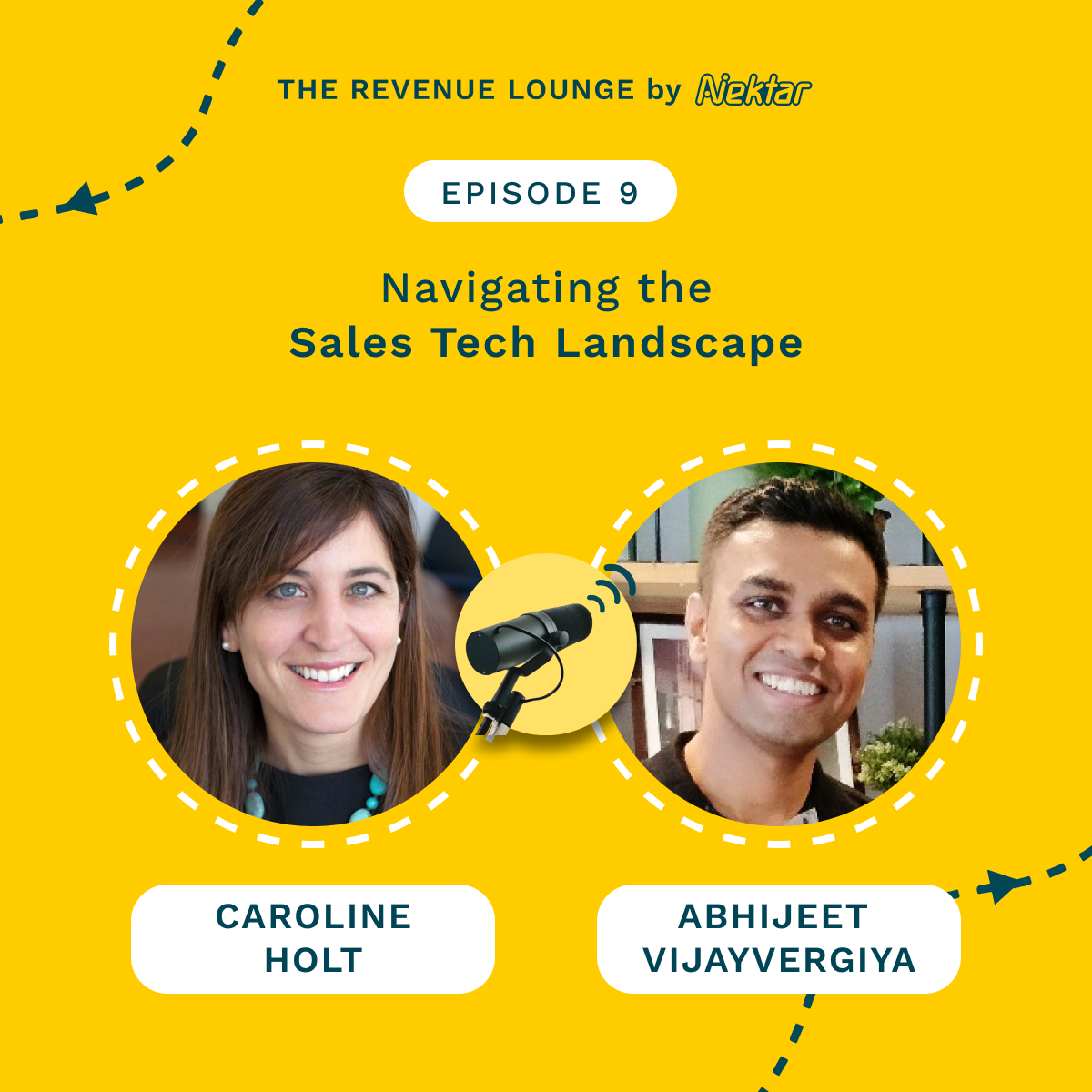
Ep #9: Navigating the Sales Tech Landscape
Listen Now